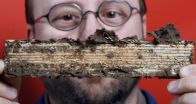(Press-News.org) Researchers at the National Institutes of Health have uncovered a molecule in an animal model that acts as a key player in establishing the organization of the auditory system. The molecule, a protein known as Bmp7, is produced during embryonic development and acts to help sensory cells find their ultimate position on the tonotopic map, which is the fundamental principle of organization in the auditory system. The tonotopic map groups sensory cells by the sound frequencies that stimulate them. The study is the first to identify one of the molecular mechanisms that determines position.
Findings from the study, led by Zoe F. Mann, Ph.D and Matthew W. Kelley, Ph.D., of the Laboratory of Cochlear Development at the National Institute on Deafness and Other Communication Disorders (NIDCD), were published in the May 20, 2014 issue of Nature Communications. The research was performed in collaboration with scientists from the University of Virginia (UVa) School of Medicine, Charlottesville, and Imperial College in London. The American Hearing Research Foundation provided additional support.
An additional study, appearing in the same edition, is led by NIDCD-supported researchers Benjamin R. Thiede, Ph.D., and Jeffrey T. Corwin, Ph.D. at UVa. Working in collaboration with Drs. Mann and Kelley, the researchers reveal that another signaling molecule, retinoic acid, acts in concert with Bmp7 to position cells.
"The findings could open doors to therapies that take advantage of Bmp7's navigational talents to direct the formation of regenerated sensory cells that are tuned to respond to a specific frequency," says James F. Battey, Jr., M.D., Ph.D., director of NIDCD. "Since many forms of hearing loss are limited to specific frequencies, this approach could lead to replacement sensory cells that are tailored to individual needs."
The human ear can detect a wide range of frequencies, from the low rumble of distant thunder to the high-pitched whine of a mosquito. The sensory cells that detect these sounds are called hair cells, named for the hair-like strands that cluster on their tops. Hair cells are spread across a flat surface called the basilar membrane, which rolls up like a carpet and tucks into a snail shell-shaped structure in the inner ear called the cochlea.
Part of what accounts for our remarkable range of hearing is that hair cells have different specializations. Rather than working to sense all audible frequencies, each of our roughly 16,000 hair cells is dedicated to a narrow range. Hair cells are ordered along the basilar membrane's length, or axis, according to the frequency they detect. Those that sense low pitches are at one end and those that detect high-frequency sounds are at the opposite end. The cells in between step through the mid-range pitches.
This spatial arrangement of hair cells on the basilar membrane–the tonotopic map—has been known for years. What hasn't been known is how each hair cell learns to "hear" specific frequencies.
"During development, hair cells at each position along the axis need to figure out where they are so that they know what frequency they should be listening to," said Dr. Kelley. "This is called positional identity. We wanted to know how hair cells figure out their position."
Dr. Kelley suspected that, like numbers on a ruler, the positions of hair cells along the basilar membrane were marked by stepwise differences in the level of a signaling molecule that would determine position. Molecular concentration gradients of this sort have been shown to steer the positioning of other cell types in the body during development.
To see if such a signaling molecule might be involved in the structural organization of the cochlea, Dr. Mann examined the basilar papilla from six-day old chick embryos. The basilar papilla in chickens is similar to the cochlea in mammals, with hair cells arranged along the length of its basilar membrane in a similar fashion according to frequency. The researchers reasoned that if a molecular concentration gradient were involved in positioning hair cells, the molecule's level would be higher at one end of the basilar papilla than the other.
When they split the basilar papilla in half looking for molecules, one stood out because of the striking difference in its level between the two halves—Bmp7—a signaling protein known to play a role in the development of bone and kidneys. Additional experiments revealed a gradual gradient in the level of Bmp7 across the length of the basilar papilla.
The researchers next showed that Bmp7 promotes the development of low-frequency-sensing hair cells. When they bathed developing basilar papillas in a solution containing Bmp7, they found that all the hair cells developed characteristics of low-frequency-sensing hair cells, even those at the high-frequency end.
These findings suggest that during embryonic development, high levels of Bmp7 at one end of the basilar papilla signal the formation of low-frequency-sensing hair cells. Decreasing levels of Bmp7 along the length of the basilar papilla map with a gradual change towards tuning to higher frequencies.
In future work, Dr. Kelley and his team aim to use a mouse model to understand the role of Bmp7 in specifying the positioning of hair cells in a mammalian organism. Bmp7 is known to be present in cells of the inner ear in mammals, suggesting a possible role for the molecule in tuning. The researchers hope to be able to outline its precise role in patterning parts of the auditory system.
"The entire auditory system is assembled according to individual frequencies," said Dr. Kelley. "Complex sounds like music or speech that consist of many different frequencies are split into individual frequencies in the ear, processed through separate channels, and then reassembled in the brain. By revealing the part played by Bmp7 in patterning hair cells in the inner ear, we may have uncovered a broader role for the molecule in the auditory system as a whole."
INFORMATION:
The research was supported by NIDCD by funds from the Intramural Research Program at the NIDCD, and NIDCD/NIH grants RC1-DC010677, R01-DC000200, and F31-DC012485.
NIDCD supports and conducts research and research training on the normal and disordered processes of hearing, balance, taste, smell, voice, speech, and language and provides health information, based upon scientific discovery, to the public. For more information about NIDCD programs, see the website at http://www.nidcd.nih.gov.
About the National Institutes of Health (NIH): NIH, the nation's medical research agency, includes 27 Institutes and Centers and is a component of the U.S. Department of Health and Human Services. NIH is the primary federal agency conducting and supporting basic, clinical, and translational medical research, and is investigating the causes, treatments, and cures for both common and rare diseases. For more information about NIH and its programs, visit http://www.nih.gov.
NIH…TURNING DISCOVERY INTO HEALTH®
NIH researchers discover key factor in early auditory system development
Finding offers insight into how sensory cells find their position
2014-05-20
ELSE PRESS RELEASES FROM THIS DATE:
Is there really cash in your company's trash?
2014-05-20
This news release is available in French. One company's trash can be another's treasure.
Take Marmite. Made from a by-product of commercial beer production, the yeast-based spread has topped toast throughout the Commonwealth for decades. By recuperating the waste product from one company, another was able to thrive.
Environmental concerns are at the forefront of government policy, so the time is right for companies worldwide to adopt this type of resource exchange, known as industrial symbiosis (IS).
A new study by Concordia University researcher Raymond Paquin ...
Engineers build world's smallest, fastest nanomotor
2014-05-20
VIDEO:
Cockrell School of Engineering assistant professor Donglei (Emma) Fan and her mechanical engineering team have built the fastest, smallest nanomotor to date. The team's nanomotor could enable controlled drug delivery...
Click here for more information.
Researchers at the Cockrell School of Engineering at The University of Texas at Austin have built the smallest, fastest and longest-running tiny synthetic motor to date. The team's nanomotor is an important step toward ...
Program to reduce behavior problems boosts math, reading, NYU Steinhardt study shows
2014-05-20
A program aimed at reducing behavior problems in order to boost academic achievement has improved performance in math and reading among low-income kindergartners and first graders, according to a study by researchers at New York University's Steinhardt School of Culture, Education, and Human Development.
Their findings, which appear in the Journal of Educational Psychology, point to the value of well-designed interventions to improve education, the study's authors say.
"Supporting young low-income children so they can reach their potential in the classroom and beyond ...
Professors' super waterproof surfaces cause water to bounce like a ball
2014-05-20
In a basement lab on BYU's campus, mechanical engineering professor Julie Crockett analyzes water as it bounces like a ball and rolls down a ramp.
This phenomenon occurs because Crockett and her colleague Dan Maynes have created a sloped channel that is super-hydrophobic, or a surface that is extremely difficult to wet. In layman's terms, it's the most extreme form of water proof.
Engineers like Crockett and Maynes have spent decades studying super-hydrophobic surfaces because of the plethora of real-life applications. And while some of this research has resulted in ...
Termite genome lays roadmap for 'greener' control measures
2014-05-20
WEST LAFAYETTE, Ind. - A team of international researchers has sequenced the genome of the Nevada dampwood termite, providing an inside look into the biology of the social insect and uncovering new genetic targets for pest control.
Michael Scharf, a Purdue University professor of entomology who participated in the collaborative study, said the genome could help researchers develop control strategies that are more specific than the broad-spectrum chemicals conventionally used to treat termite infestations.
"The termite genome reveals many unique genetic targets that can ...
Fairy circles apparently not created by termites after all
2014-05-20
This news release is available in German. Leipzig. For several decades scientists have been trying to come up with an explanation for the formation of the enigmatic, vegetation-free circles frequently found in certain African grassland regions. Now researchers have tested different prevailing hypotheses as to their respective plausibility. For the first time they have carried out a detailed analysis of the spatial distribution of these fairy circles – and discovered a remarkably regular and spatially comprehensive homogenous distribution pattern. This may best be explained ...
Fossils prove useful in analyzing million year old cyclical phenomena
2014-05-20
Research conducted at the University of Granada has shown that the cyclical phenomena that affect the environment, like climate change, in the atmosphere-ocean dynamic and, even, disturbances to planetary orbits, have existed since hundreds of millions of year ago and can be studied by analysing fossils.
This is borne out by the palaeontological data analysed, which have facilitated the characterization of irregular cyclical paleoenvironmental changes, lasting between less than 1 day and up to millions of years.
Francisco J. Rodríguez-Tovar, Professor de Stratigraphy ...
Improved computer simulations enable better calculation of interfacial tension
2014-05-20
Computer simulations play an increasingly important role in the description and development of new materials. Yet, despite major advances in computer technology, the simulations in statistical physics are typically restricted to systems of up to a few 100,000 particles, which is many times smaller than the actual material quantities used in typical experiments. Researchers therefore use so-called finite-size corrections in order to adjust the results obtained for comparatively small simulation systems to the macroscopic scale. A team of researchers from Johannes Gutenberg ...
Particles near absolute zero do not break the laws of physics after all
2014-05-20
In theory, the laws of physics are absolute. However, when it comes to the laws of thermodynamics—the science that studies how heat and temperature relate to energy—there are times where they no longer seem to apply. In a paper recently published in EPJ B, Robert Adamietz from the University of Augsburg, Germany, and colleagues have demonstrated that a theoretical model of the environment's influence on a particle does not violate the third law of thermodynamics, despite appearances to the contrary. These findings are relevant for systems at the micro or nanometer scale ...
Busting rust with light: New technique safely penetrates top coat for perfect paint job
2014-05-20
WASHINGTON, May 20, 2014 – To keep your new car looking sleek and shiny for years, factories need to make certain that the coats of paint on it are applied properly. But ensuring that every coat of paint—whether it is on a car or anything else—is of uniform thickness and quality is not easy.
Now researchers have developed a new way to measure the thickness of paint layers and the size of particles embedded inside. Unlike conventional methods, the paint remains undamaged, making the technique useful for a variety of applications from cars to artifacts, cancer detection ...
LAST 30 PRESS RELEASES:
Longest observation of an active solar region
Why nail-biting, procrastination and other self-sabotaging behaviors are rooted in survival instincts
Regional variations in mechanical properties of porcine leptomeninges
Artificial empathy in therapy and healthcare: advancements in interpersonal interaction technologies
Why some brains switch gears more efficiently than others
UVA’s Jundong Li wins ICDM’S 2025 Tao Li Award for data mining, machine learning
UVA’s low-power, high-performance computer power player Mircea Stan earns National Academy of Inventors fellowship
Not playing by the rules: USU researcher explores filamentous algae dynamics in rivers
Do our body clocks influence our risk of dementia?
Anthropologists offer new evidence of bipedalism in long-debated fossil discovery
Safer receipt paper from wood
Dosage-sensitive genes suggest no whole-genome duplications in ancestral angiosperm
First ancient human herpesvirus genomes document their deep history with humans
Why Some Bacteria Survive Antibiotics and How to Stop Them - New study reveals that bacteria can survive antibiotic treatment through two fundamentally different “shutdown modes”
UCLA study links scar healing to dangerous placenta condition
CHANGE-seq-BE finds off-target changes in the genome from base editors
The Journal of Nuclear Medicine Ahead-of-Print Tip Sheet: January 2, 2026
Delayed or absent first dose of measles, mumps, and rubella vaccination
Trends in US preterm birth rates by household income and race and ethnicity
Study identifies potential biomarker linked to progression and brain inflammation in multiple sclerosis
Many mothers in Norway do not show up for postnatal check-ups
Researchers want to find out why quick clay is so unstable
Superradiant spins show teamwork at the quantum scale
Cleveland Clinic Research links tumor bacteria to immunotherapy resistance in head and neck cancer
First Editorial of 2026: Resisting AI slop
Joint ground- and space-based observations reveal Saturn-mass rogue planet
Inheritable genetic variant offers protection against blood cancer risk and progression
Pigs settled Pacific islands alongside early human voyagers
A Coral reef’s daily pulse reshapes microbes in surrounding waters
EAST Tokamak experiments exceed plasma density limit, offering new approach to fusion ignition
[Press-News.org] NIH researchers discover key factor in early auditory system developmentFinding offers insight into how sensory cells find their position





